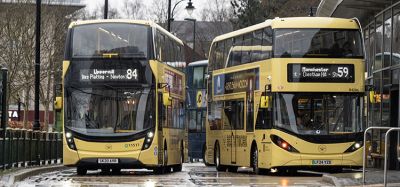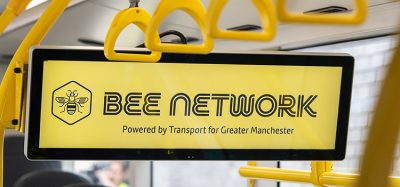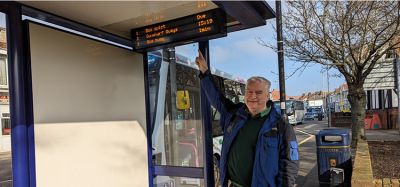RTI for Greater Manchester
- Like
- Digg
- Del
- Tumblr
- VKontakte
- Buffer
- Love This
- Odnoklassniki
- Meneame
- Blogger
- Amazon
- Yahoo Mail
- Gmail
- AOL
- Newsvine
- HackerNews
- Evernote
- MySpace
- Mail.ru
- Viadeo
- Line
- Comments
- Yummly
- SMS
- Viber
- Telegram
- Subscribe
- Skype
- Facebook Messenger
- Kakao
- LiveJournal
- Yammer
- Edgar
- Fintel
- Mix
- Instapaper
- Copy Link
Posted: 1 April 2005 | Bill Tyson OBE Chairman and Managing Director, Transport Management Group Ltd. | No comments yet
Greater Manchester’s real time information system grew out of the Integration Project. This was formally launched in 1998 and is a collaborative partnership between GMPTE and the Passenger Transport Authority, other public authorities and the private sector operators of all three modes of public transport in Greater Manchester.
The key objectives are to improve the quality of public transport and to present it to passengers and potential passengers as an integrated high quality network that is easy to understand and use and is increasingly acceptable as an alternative to the car.
Greater Manchester’s real time information system grew out of the Integration Project. This was formally launched in 1998 and is a collaborative partnership between GMPTE and the Passenger Transport Authority, other public authorities and the private sector operators of all three modes of public transport in Greater Manchester. The key objectives are to improve the quality of public transport and to present it to passengers and potential passengers as an integrated high quality network that is easy to understand and use and is increasingly acceptable as an alternative to the car.
Greater Manchester’s real time information system grew out of the Integration Project. This was formally launched in 1998 and is a collaborative partnership between GMPTE and the Passenger Transport Authority, other public authorities and the private sector operators of all three modes of public transport in Greater Manchester.
The key objectives are to improve the quality of public transport and to present it to passengers and potential passengers as an integrated high quality network that is easy to understand and use and is increasingly acceptable as an alternative to the car.
The Integration Project has five main themes for improving the quality of public transport in the following areas:
- Passenger information
- The waiting environment
- Services
- Ticketing
- Connections and interchange
A network of Quality Bus Corridors forms the cornerstone of the efforts to improve the quality of bus services. This network will cover about 400 kilometres of the busiest bus corridors in the county. A whole series of improvements are targeted on the QBCs including:
- Extensive bus priority using bus lanes and priority at traffic signals
- Improvements to pedestrian access to bus stops
- Improvements to bus stops including cleared bus stop signs, bus shelters at most stops, and level access between the kerb and the bus
- New, low floor, low emission, and high quality buses
- Better lighting
- More pedestrian crossing points
- Taking parking from the road into off-road bays
Real time information
The original interest in real time information came as part of the QBC programme. We recognised that a real time information system could provide:
- Information to passengers at stops on the time of the next buses
- A more sophisticated means of giving buses priority at traffic signals, with the degree of priority related to the timing of the bus
• On-bus displays telling passengers the name of the next stop
This would, in fact, address four of the Integration Project’s policy areas by:
- Improving passenger information
- Improving the waiting environment by giving information on the time of the next bus
- Improving services by reducing delays at traffic signals – this reduces journey times and improves reliability
- Helping passengers making interchange journeys by providing real time departure information at interchanges
At the time the QBC programme started in 1999, real time information was not a priority but in the course of the next year or so it rose up the priority list for a number of reasons. These included:
- Real time systems could deliver information to those planning and monitoring the performance of the Quality Bus Corridors that would enable them to identify the location of delays. This would enable bus priority measures to be better targeted.
- The systems could also give operators more information on the operational performance of their buses and their services. This would enable them to produce more reliable timetables that more accurately reflect actual traffic conditions on a route.
- There is potential for further integration with the operator ‘back office’ systems including scheduling, vehicle and crew allocation leading to more efficient and cost effective operation.
- The real time equipment could be linked to the ticket machine that could be automatically updated as the bus progressed along its route. This would reduce the incidence of passengers being charged the wrong fare and reduce disputes between passengers and drivers.
- The real time system could give the driver continuous information on whether the bus was early, on time or late, which would help with schedule adherence and deliver an even more reliable service to passengers.
- Developments in information technology meant that real time information could be made available to passengers before they started their journeys both by Internet and by SMS messages to mobile phones. Thus the potential for passengers to benefit is greatly increased, as real time information can be made available even at stops where there is no display.
The partnership
The list of benefits in the previous paragraph makes it clear that the original list was only scratching the surface. Furthermore, there were benefits to passengers, operators and GMPTE. As a result, a partnership was formed between GMPTE and four bus operators to introduce a real time information system in Greater Manchester. The nature of this partnership is that GMPTE – funded by the Passenger Transport Authority – is meeting the cost of installing the central system (software, garage equipment and main server); the costs of the at-stop displays and the communication costs to the displays. Operators are meeting the costs of the on-bus equipment and the communication costs to and from the bus.
Phase 1
Clearly, such an ambitious project needed to be undertaken in phases as funding became available. The first phase of the project, which is capable of being extended to all bus services in Greater Manchester, covered a number of services on six QBCs together with three other services that were the subject of a quality improvement programme. These included the free Metro Shuttle services in central Manchester that are used by over one million passengers per year. This covered just over 300 buses and about 100 at-stop displays.
Besides being one of the biggest real time contracts outside London at the time it was let, the Manchester system has a number of other features that at the time were unusual. The most important of these is the use of a public telecommunications network – GPRS – for the communication requirements. Many other systems use a private mobile radio network (PMR) which involves setting up a network of base stations and obtaining an allocation of radio spectrum from that allocated to the bus industry. Following this approach in Greater Manchester would have been very expensive.
The contract
After an EU wide procurement process, the contract for Phase 1 of the system was awarded by GMPTE to Infocell Technology. A similar process resulted in the communications contract being awarded to Orange. The Infocell system works using exception reporting, the reconciliation between scheduled and actual time at every point for which a GPS reference is received takes place on the bus. The need to transmit information between the bus and the central server only arises if the bus is early or late. Similarly, the displays store the schedules for all the buses using them, and only need to receive a signal if the bus is early or late. This approach helps to minimise communications costs and makes the GPRS system using a public network affordable.
Whilst the main contract is between GMPTE and Infocell, GMPTE has ‘back to back’ contracts with the operators – First, Stagecoach, Blue Bird and Blue Bus. The latter companies are independent operators and are not part of any of the large bus operating groups.
Phase 2
GMPTE was fortunate in being awarded funding approvals of just over £1 million in 2002 as part of the Department for Transport’s £20 million programme to expand real time information systems. This led to another procurement exercise and resulted in a further contract for Infocell. This contract is of a call-off nature, that allows additional on-bus equipment and signs to be purchased as resources become available.
Experience to date
Implementing the system has been more complex than any of the parties to the contract expected at the outset. There have been several reasons for this. The most important is the number and complexity of the interfaces both within the system and externally. These include:
- Fitting the equipment to the buses. This is a complex process that has to be carried out at night when the bus is out of service. Individual buses, even from the same batch, have individual differences that affect the installation process. It is not always possible for the specific buses to be available for fitting – for example if they suffer accident damage.
- Connecting to the ticket machine. This is an essential part of the system and needs a two way link. The ticket machine tells the RTI system which service and journeys the bus is operating, whilst the RTI tells the ticket machine where the bus is. Several manufacturers and models of ticket machine have to be dealt with and again, individual machines and buses can vary.
- Getting the data. The RTI system needs data on the timetabled departure time at each stop on each journey that a bus at each garage can operate. This is a large amount of data, which has to be clean and in a set format for the RTI system. Data items, like stop names, need to be consistent between this and other systems. Initially this was a totally manual process but steps are in hand to automate it.
- Maintaining the equipment and systems – if a bus is transferred to another garage or another fleet, or is sold, the RTI equipment needs to be modified or taken out and fitted to the replacement bus.
- Transmitting the data. In the early stages, the interfaces between the RTI system and the GPRS network had to be ‘debugged’.
- The displays have to be fitted into the shelters, which needs a power supply, thus creating yet more interfaces.
All this is having to be done over and above the day to day job of running a bus service and has, at times, had to take second place to other priorities for a time. The RTI system itself has needed further modification and development following large scale operating experience.
The results
These and other problems have been overcome by hard work and partnership on the part of all the parties involved, GMPTE, Infocell, Orange and the bus operators, all of who have been fully supportive of the project. The system is now installed on four services with more following very quickly. Initially, the system runs in ‘silent’ mode until all parties are satisfied that it is stable and producing accurate results, then the signs are switched on for a period of test running. Finally each service is commissioned.
A successful interface between the real time system and an SMS messaging system has been developed. This will be made available to the public as new routes are commissioned.
It is too early to quantify the impacts and benefits of the system although GMPTE and the operators will be carrying out an evaluation exercise. For the moment the emphasis is on completing the installation programme that will now cover about 500 buses and 200 displays.
Related topics
Travel & Passenger Information
Issue
Issue 1 2005








